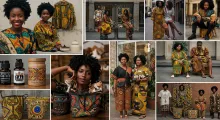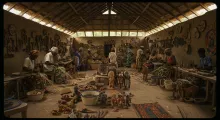In a rapidly globalizing world, many African children are growing up knowing more about Queen Elizabeth than Queen Amina, more about the Greek gods than the Yoruba pantheon, and more about the Boston Tea Party than the Aba Women's Riot. This disconnect from African history isn't just a loss of knowledge—it's a loss of identity, pride, and power.
But storytelling—the oldest form of education across African cultures—offers a powerful way to reconnect children with their roots. Unlike dry textbooks or rote memorization, storytelling makes history vibrant, personal, and unforgettable.
In this post, we explore why storytelling is the most effective method for teaching kids African history, how to do it meaningfully, and examples of stories and methods that work.
Why Storytelling Matters in Teaching African History
For centuries, African societies passed down their history through oral traditions: griots in West Africa, imbongis in Southern Africa, and praise singers in various regions. These storytellers preserved everything from family genealogies to battle victories, agricultural cycles to spiritual beliefs.
Children sat around fires, under moonlit skies, hearing stories that were not just entertaining but loaded with values, wisdom, and historical memory. Bringing this tradition into modern classrooms or living rooms can reignite a deep connection to the continent’s legacy.
The Benefits of Using Storytelling to Teach History
- Makes History Relatable: Kids understand and remember stories better than dates or treaties. Through characters and conflicts, they connect emotionally with the past.
- Builds Cultural Pride: Hearing stories of brave queens, wise elders, and powerful kingdoms instills a sense of pride in African identity.
- Passes on Values: Stories teach lessons—about justice, respect for elders, courage, cooperation, and resilience.
- Promotes Listening and Speaking Skills: Storytelling is interactive. It teaches kids to pay attention, ask questions, and express themselves.
- Balances Eurocentric Curricula: Most formal education systems in Africa still prioritize Western history. Storytelling can help correct that imbalance informally and naturally.
How to Teach African History Through Storytelling
1. Start with Heroes and Heroines
Children love role models. Start by introducing them to figures like:
- Queen Amina of Zazzau – the warrior queen who expanded her territory in what is now northern Nigeria.
- Samori Touré – a fierce resister of French colonization in West Africa.
- Makeda (Queen of Sheba) – whose legend connects Ethiopia with ancient global diplomacy.
- Yaa Asantewaa – the Ashanti queen mother who led a war against British colonizers in Ghana.
- Shaka Zulu – the military genius who revolutionized warfare in Southern Africa.
Use stories that focus on their childhoods, decisions, challenges, and courage to humanize them for young audiences.
2. Incorporate Myths and Legends with Real History
Stories about Ananse the Spider or Mami Wata aren’t just folklore—they're vehicles for values and sometimes coded historical memory. Use these tales to introduce deeper discussions:
- What do these stories tell us about traditional beliefs?
- How did colonialism affect how we see these characters today?
3. Use Visuals and Props
Children love to see as much as they hear. Use:
- Illustrated books or comic-style biographies (e.g., "Njinga of Angola" or "Shaka Zulu: The Great Warrior").
- Puppets or paper dolls dressed in traditional attire.
- Short animations (YouTube has growing content in this niche).
These visuals help bring history to life.
4. Connect Stories to Geography
When telling the story of the Mali Empire, show a map. When narrating the journey of the Bantu migrations, trace it visually. This helps kids locate themselves on the continent and grasp its diversity.
5. Include Personal or Family History
Tell children about their own lineage: a grandfather who fought in a war, a grandmother who was a merchant, a family name with royal or ancestral significance. Personal history connects them directly to the grander narrative of Africa.
6. Make It Interactive
Ask children to retell the story in their own words. Have them act it out, draw scenes from the story, or even reimagine how the characters might behave today.
Example activity: After telling the story of Queen Amina, ask, “If Amina were alive today, what kind of leader would she be? Would she use social media? What battles would she fight now?”
Sample Stories and How to Tell Them
The Kingdom of Mali and Mansa Musa
Tell the story of the richest man who ever lived, Mansa Musa. Describe his pilgrimage to Mecca, his generosity, and how he built libraries and mosques. Use vivid imagery: gold dust trailing from camels, thousands of people walking across the desert, the surprise of Egyptians when he arrived.
Moral: Wealth is not just about money but about knowledge, leadership, and faith.
The Aba Women’s Riot of 1929
Describe how Igbo and Ibibio women protested colonial taxation. Tell it from the perspective of a young girl who watched her mother join thousands of women in song and defiance.
Moral: Women have always been leaders, even in protest.
The San People’s Creation Story
Use the Bushman story of the trickster god /Kaggen, the praying mantis, and how he shaped the world. Link this to the San's ancient rock art and their role as Africa’s oldest inhabitants.
Moral: All cultures have deep knowledge and connections to nature.
Recommended Resources for Parents and Educators
- Books:
- Nelson Mandela’s Favorite African Folktales
- African Myths of Origin by Stephen Belcher
- The Royal Kingdoms of Ghana, Mali, and Songhay by Patricia and Fred McKissack
- Story Story: How History Was Made by Just Us Books
- YouTube Channels:
- African History Club for Kids
- BBC Africa Kids Stories
- AfroTales
- Podcasts:
- Anansi Storytime
- African Folktales with Miss Jo Jo
Rekindling the Griot Spirit
Teaching kids African history through storytelling is more than an educational method—it’s a reclamation. It brings identity, pride, and belonging into their everyday lives. In a world full of competing narratives, our children deserve to know where they come from, who they are, and the greatness they inherit.
So gather around. The fire may now be a lamp or laptop screen, but the stories—and their power—remain the same.



